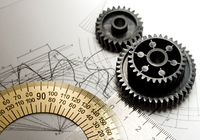Block & Slice
The program OpenSCAD makes it possible to construct 3D objects via just a few commands. STL Exporter makes the software interesting for users who have a 3D printer.
|

Sergey Jarochkin, 123RF
The program OpenSCAD makes it possible to construct 3D objects via just a few commands. STL Exporter makes the software interesting for users who have a 3D printer.
OpenSCAD makes you feel right at home once you know that a radius defines a sphere or that height and diameter define the surface of a cylinder. The OpenSCAD design software also lets you create structures for printing with a 3D printer. The tests performed for this article produced a cap for a USB stick, a model airplane, Lego bricks, and a replacement key.
Popular distributions offer OpenSCAD for installation, which is usually the 2104 version. The software homepage [1] explains how to download the updated version 2015.03-1. Downloading the newer version is worthwhile because it offers the possibility of directly incorporating text objects.
Once the software starts, a window will open with an input area to the left, an output area to the right and a console. Various buttons offer basic functions. The icons to the left in the editor window are for common tasks such as opening and saving files, and typical editing actions, such as undoing, repeating and indenting.
[...]
Pages: 6
Putting together realistic models on a computer screen can be useful and fun. LeoCAD
GeoGebra breathes life into dry numbers. With a few clicks, you can discover @#the beauty of polynomials and functions.
The Inkscape vector graphics program not only lets you work with pencil and ink lines, it can help you mimic the elegant brushstrokes of an oil painting. Our three easy-to-follow examples show you how.
Light pollution and cloud coverage often obscure views of the night sky and stars above. Enter Stellarium for the PC; this free, open source program can make even distant galaxies visible to the user.
Network plans, nested dependencies, or binary trees – with Graphviz, you can visualize complex relationships in a simple way.
© 2026 Linux New Media USA, LLC – Legal Notice